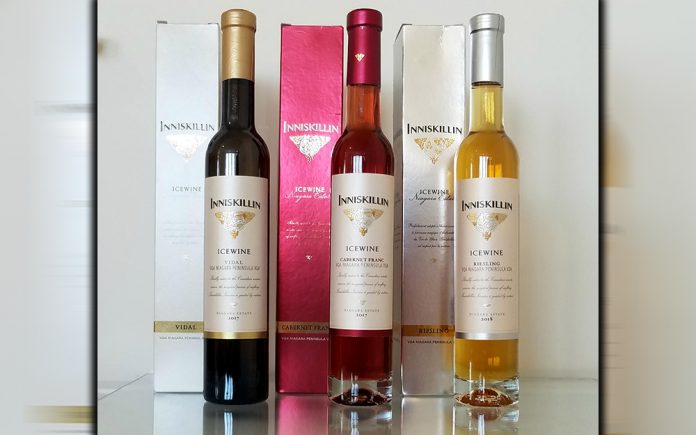
By Rick Riozza
Whenever I get into a lively wine discussion, invariably, when the topic moves to “dessert wines”, some folks immediately equate that to “sweet wines”, and they’ll comment, “Oh—I never drink sweet wine” or, “I hate sweet wines!” And to quote one of our all-star tennis legends, I’ll accuse with, “You can’t be serious!”
But of course, they are serious—if one thinks a “dessert wine” is simply a “sweet wine”. But world-class stuff isn’t simply sweet. They (the Sauternes, Tokaji, Ports, Madeira, Vin Santo, etc.) offer a variety of stunning tastes and balanced complexities that can simply bowl over any vino enthusiast’s demands and expectations. Indeed, icewines are extraordinarily sweet but yet balanced by laser-focused acidity exhibiting bright fruit essences
And surely we include the Icewines of the cold countries in the mix of world-class wines. About every other winter season, this column has written about ice wines; and we usually talk about the famous and traditional ice wines of Europe—Germany particularly. This time, we’ll discuss matters closer to home.
Canada, like Germany, have early and cold winters in common, and produce the best icewines in the world and are the leading producers of “traditional” icewines. I use the word traditional because theirs is the process of working with God-given cold-snowy weather. Arguably, every region around the world can produce an icewine by freezing water-soaked grapes—but as one can discern with that simple description, that ain’t gonna come close to the real thing.
And for those wine folks who’ve never really studied or spoken about icewine, or have forgotten the arduous process involved, here’s a quick primer:
Quoting myself from another column, “It’s been called one of the sweetest mistakes nature has ever made. Reason being, probably no one would have ever purposefully produced it. The entire process of producing ice wine is very difficult. Icewine (or Eiswein) is made from desiccated grapes that have been frozen on the vine over the night and are picked at dawn while still frozen. Harvesting grapes is a tough job; doing so in sub-zero temperatures battling frostbite, in the dark, on a moments alert, and getting it all done before the next morning’s sunshine can be described as misery.”
Once they are picked, the grapes are crushed and pressed as whole bunches (with the usual difficulty—it could be like working with marbles), and, the ice remains with the skins in the press.
Remembering that they are working with “desiccated” grapes; there’s the prayer that each individual grape still has a drip of fruit essence livened by a drip of water. The fermentation process gets a bit nerdy
But it is that juice—a touch of essence and a touch of frost—that is magic! And only about a tenth to a fifth of the sparse liquid in these frozen grapes is used for ice wine because the juice is so sweet. Thereafter it can take anywhere from 3 to 6 months in a long slow, finicky fermentation to make ice wine. The final alcohol content will range from 7% to 10% and has almost double the sweetness of a Coca-Cola.
But never think is tastes like a Coke! Ice wine usually has a medium to full body, with a long lingering finish. The nose and palate is usually reminiscent of peach, pear, dried apricot, honey, citrus, figs, caramel, green apple. Further aromas of tropical and exotic fruits such as pineapple, mango, or lychee are also quite common.
But the most impressive thing is that while ice wines are extraordinarily sweet, there’s a great freshness in its searing acidity that keeps the wine scintillating. Fortunately for me, icewines were some of the first world class wines I was ever introduced to back in the day.
As Canada’s original estate winery, Inniskillin is the industry pioneer committed to the production of premium wines made from quality grapes grown in Canada for over 35 years. With wineries in Niagara-on-the-Lake, Ontario and the Okanagan Valley, British Columbia, they continue leading the way with a full collection of world renowned, award-winning table wines and Icewines crafted by progressive, artisanal winemakers.
Inniskillin’s Icewine’s roots can be traced to centuries old German winemakers. Further, they are innovative when it comes to the number of different varieties they produce. I’ve just tasted through Inniskillin’s three stellar Icewines, Vidal, Riesling and Cabernet Franc. I recommend these wines most heartily; here are my comments:
Inniskillin 2017 Vidal Icewine ($49.95/375 ml) this is a Sauternes lover’s wine; very similar in structure with all the fresh tropical fruits of pineapple, apricot, and mango, along with ripe peach and lively citrus. Aromatic and lush with complexities of a marmalade and a long-balanced finish of candied fruit and acidity. A Classic Canadian Icewine to be savored by any wine enthusiast.
Inniskillin 2018 Riesling Icewine ($79.95/375 ml) we know the Riesling grape is full of aromatics and this wine does not disappoint as it shows a fragrant bouquet of lemon-lime notes, apricot, honey, orange peel, stone fruit pit. Full-bodied and refreshing at the same time, following with white peaches, nectarines, apricots, oranges, and hints of zesty spices. Layers of complexities include pineapple and orange marmalade. That description alone foretells the long long finish. A bunch of top restaurants have this glass of wine on their dessert menus.
Inniskillin 2017 Cabernet Franc Icewine ($84.99/375 ml) this is a wonderful variation on an Icewine theme: A luscious (and rare) red Icewine! You red wine fans will be impressed to no end with the bursting aromas of strawberry that flow into the palate of red berries, brandied cherries, stewed plum and strawberry rhubarb and cherry with hints of fresh cream.
Rich and refreshing, balanced, and incredibly complex: talk about a Valentine’s wine pairing with chocolate, strawberries and cream. Cheers! & Sweet Dreams!










































